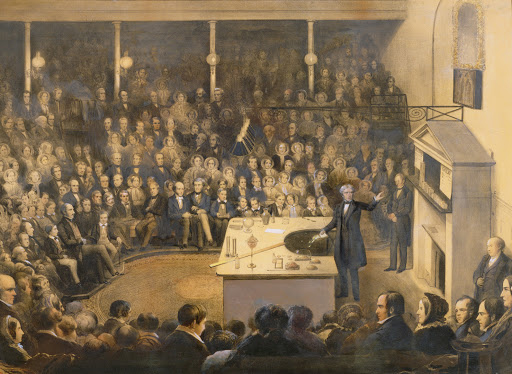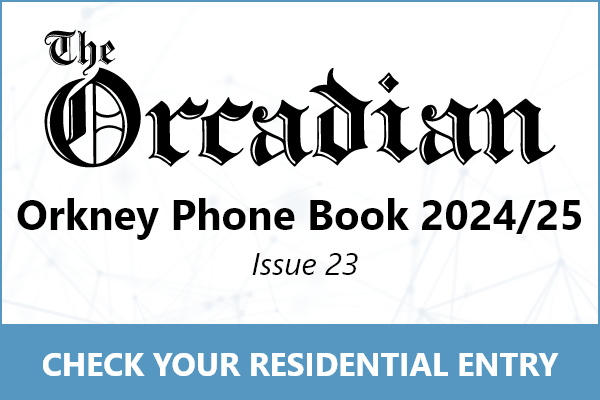How does Orkney connect Michael Faraday and Mrs Beeton’s Cookbook?

By Patricia Long
Thanks to the internet, it is now possible to put together stories of how Orcadians have influenced the wider world.
This leads to all sorts of surprising connections, and I did a series of them for BBC Radio Orkney several years ago. This is an extended version of one of them.
Michael Faraday was one of the world’s greatest scientists.
He was also one of the first to recognise the importance of reaching a wider audience and he had the perfect venue for this, at the Royal Institution in London. The lecture theatre there is probably the most famous in the world, thanks to the Christmas Lectures he began in 1825, which have been televised since 1966. It was designed by an Orcadian, Thomas Webster.
Thomas’s father Alexander was English, but his mother Mary was the daughter of Thomas Baikie, the minister at St Magnus Cathedral, and Thomas grew up in Orkney.
According to his entry in the Oxford Dictionary of National Biography, he attended Kirkwall Grammar School, and then went to Aberdeen University in 1785, where “he assisted Professor Patrick Copland, a populariser of science.” Professor Copland was a pioneer of public education, whose extramural classes ran from 1785 to 1813. He also pioneered the use of demonstrations in his lectures, so Thomas may have taken a few new ideas with him when he went to London.
Thomas Webster enrolled at the Royal Academy Schools in London as an architectural student in 1793, and had his own business by 1799. He began “a school for mechanics,” and this came to the attention of Count Rumford, one of the founders of what became the Royal Institution. Rumford’s aim was to encourage the use of mechanical inventions and improvements, and to encourage “the Application of Science to the Common Purposes of Life.”
At the age of 26, Webster was engaged as treasurer and secretary of the Institution and, as Clerk of Works, superintended the transformation of a house into a suitable building. In January 1800, he was told to prepare plans for a new lecture room. Many years later he wrote:
The theatre of the Royal Institution is pronounced to be the most perfect room of the kind in the kingdom for possessing the properties of allowing the lecturer to be well heard and seen by the audience and for affording them easy entrance and exit, &c . . . it has been stated by Faraday, in his late examination before a committee of the House of Commons, to be ‘almost perfect as a lecture room,’ and that ‘although architects are continually measuring and drawing it to copy from, and many other rooms have been built in imitation of it in which he has tried his voice, yet none of them proved equal to that in question.
Sir Humphrey Davy was the first scientist to draw crowds to the lecture theatre, which could seat 900 people. He also made good use of the laboratory which Thomas Webster had installed, using electrolysis to discover sodium and potassium. Webster wrote later: “The chemical laboratory in which so many valuable discoveries have been made was not only designed and built by me, but owes to me its very existence, for, though I inserted it in my plans, the managers did not at first consider it necessary.”
Count Rumford had assured Webster that he was going to establish a science school for workmen and, as he wrote to a friend:
It was through the prospect of being employed in this way, which would have been as agreeable to my habits of thinking as useful to my interest, that I was induced to give up the school which I then kept and the other business in which I was engaged, and to accept of a situation and salary in the Institution by no means equivalent to what I should have considered myself as entitled to under other circumstances.
Eighty years before compulsory education, he had found that new techniques in building needed better-educated workmen.
Knowing from previous experience what it was possible to effect in their improvement, I conceived the idea of giving to mechanics for this purpose a species of scientific education suited to their condition, and I believe I was the first person in this country who took active steps for effecting so desirable an object. I was not unacquainted with the political feelings of that time, but I did not think a little learning was a dangerous thing if judiciously bestowed . . . My idea was to make good mechanics, not to force them like hot-bed plants out of the sphere in which they are so useful.
Webster succeeded in convincing the managers that the school was a good idea. News of the school was published, and was very well received. Sadly, after all the preparations were made, ideas changed.
I was asked rudely what I meant by instructing the lower classes in science. I was told likewise that it was resolved upon that the plan must be dropped as quietly as possible.
It was thought to have a dangerous political tendency, and I was told that if I persisted, I would become a marked man!
Webster decided to leave the institution and embark on another career, as a landscape artist.
This somehow led to work on textbooks and a commission in 1809, to draw one of the first geological maps of England. Geology was a very new science; the Geological Society had only been founded in 1807. Sir Henry Englefield, President of the Society, commissioned Webster to survey and draw the geology of the Isle of Wight. This was published in 1816.
Ten years later, Webster became the secretary of the Geological Society and curator of its museum. Soon, he was back at the Royal Institution.
Notices of lecture courses in the 1830s include Faraday on chemistry and Webster on geology. He gave the Christmas Lectures, “suitable for a juvenile auditory,” in 1830.
University College London was founded in 1828, and Webster became its first professor of geology in 1842.
He is described as the first professional geologist, because it was then still seen as a gentleman’s hobby. Unfortunately, this meant that he was poorly paid and, although he was awarded a government pension of £50 a year for services to geology, he had to find other sources of income.
For the last ten years of his life, he worked on a commission from Longmans Publishing. The enormous Encyclopedia of Domestic Economy brought together all “the information useful to persons who have to superintend domestic establishments.” It begins with where to build your house, and goes on to cover everything from the different options for heat and light to the preparation of every sort of beverage, from gin to coffee.
It is now well known that Isabella Beeton stole material shamelessly for her Book of Household Management, published in 1859.
Her main source was Webster’s Encyclopedia: on the Arrangement of the Kitchen and General Observations, on beverages, bread, etc. Thomas Webster was unable to complain about her plagiarism.
He had died aged 72 in December 1844. He was a man ahead of his time, so got neither the payment nor recognition that he deserved but his writing, though uncredited, has stood on more bookshelves than all other Orcadian writers put together.
Mrs Beeton’s Cookbook sold two million copies in its first decade alone.
- Patricia Long is a local tour guide based in Stenness, with a particular interest in social and family history. Her website can be found at www.aboutorkney.com


